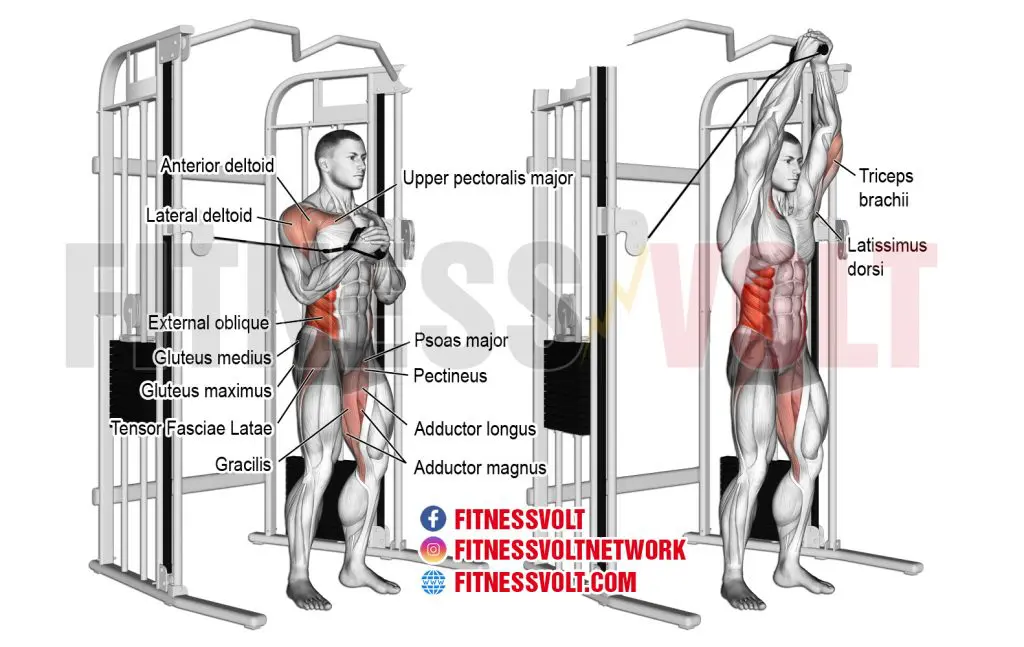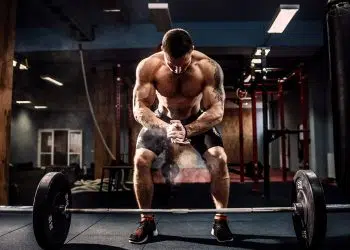As an American Council On Exercise-certified personal trainer, I work with several new clients each month. After analyzing hundreds of training programs, the most common pattern that I see is that only a handful of exercisers focus on their anti-rotation and anti-lumbar extension capabilities.
These muscles are crucial in exercises that require significant core engagement, such as squats, deadlifts, and overhead presses, and this is precisely where the start of this article shines.
The Pallof press, the namesake of the physical therapist John Pallof, is a very effective anti-rotational exercise utilized to train the core and several important muscles that play a role in optimal stability and function. (1)
Since this exercise is not as common as the plethora of stability movements performed in most gyms, you may have never seen or heard of it. However, that doesn’t mean you shouldn’t incorporate it into your training routine every week from this point on.
I’ve compiled a comprehensive guide detailing all the information about this exercise you need to build a chiseled physique.
Pallof Press Exercise Instructions: Step-By-Step Guide
The Pallof press is a straightforward exercise, but it does need to be done correctly to get the best bang for your buck. This exercise involves holding a taut resistance band or cable in front of your torso, then slowly and fully flexing and extending your elbows.
Level Up Your Fitness: Join our 💪 strong community in Fitness Volt Newsletter. Get daily inspiration, expert-backed workouts, nutrition tips, the latest in strength sports, and the support you need to reach your goals. Subscribe for free!
The pull of the training equipment during the Pallof press fires up the stabilizer muscles. The lifter must resist the rotational force to keep their torso steady throughout the exercise.
This exercise engrains the importance of bracing the core throughout the movement, which is an absolute must during compound exercises like bench presses, squats, and deadlifts.
You can use a cable pulley or a resistance band for the Pallof press. Remember, standing with a wider-than-shoulder-width stance will make the exercise easier, and a more narrow stance will increase exercise difficulty.
Step-By-Step Instructions
This is how to perform the Pallof press with the picture-perfect form:
Step One — Set Up the Equipment
Adjust the cable pulley at chest height or anchor one end of a resistance band to a sturdy object like a squat rack at chest height. For the sake of this demonstration, we will stick with the resistance band variation of the Pallof press.
Pro Tip: Choose an appropriate weight on the cable pulley or an adequately strong resistance band. The rotational pull shouldn’t be so strong that it prevents you from maintaining a steady torso.
Step Two — Hold the Resistance Band
Position yourself with your right side towards the squat rack, ensuring your shoulders are aligned with the pole of the squat rack to which the resistance band is anchored. Grab the other end of the resistance band with both hands and interlock your fingers to ensure security. Hold the resistance band at a mid-chest level and close to your sternum but not touching.
Pro Tip: Use this time to ensure your setup is correct. Adjust the height of the anchored resistance band if your hand position feels awkward.
Step Three — Get Into the Starting Position
Take a few steps away from the squat or power rack. Assume a hip-width stance and bend your knees slightly to get into an athletic posture. Your shoulders, hips, knees, and ankles should be stacked throughout the exercise.
Remember, you should be able to hold the resistance band in front of your torso throughout the range of motion. If you feel your torso tilting toward the squat rack, move closer to the anchor point.
The tension on the resistance band should be enough that you must fight against it to maintain a steady torso. A band that is too taut or not tight enough will lead to suboptimal results.
Pro Tip: While using a cable pulley machine, it doesn’t matter how far you step out, as the resistance profile remains roughly the same. However, with resistance bands, the farther you move away from the base, the more resistance you’ll create.
Step Four — Press!
While maintaining and keeping your elbows tucked, extend your arms so they are parallel to the floor. Keep your shoulder blades pulled back and depressed throughout the range of motion. Hold the isometric contraction point at the top for a couple of seconds.
Pro Tip: Keep the movement slow and controlled, and avoid rushing through the reps. Feel your core fighting the rotational pull; contract your midline throughout the exercise.
Step Five — Return to the Starting Position
Reverse the movement to pull your hands into your lower chest. Avoid driving your chin into your upper chest while performing this exercise, as it can lead to upper back stimulation.
Repeat the Pallof press on one side for the recommended reps before switching sides.
Pro Tip: Ensure you perform the same number of reps on each side to prevent strength and muscle imbalance.
Important Pallof Press Movement Tips:
- Vary the Pallof press tempo to ensure overall development. Switch between slow eccentrics, concentrics, and longer isometric contraction holds to maximize muscle fiber stimulation.
- Implement pause reps where you isometrically hold the weight for a desired number of seconds to test and improve your stability.
- Take an athletic stance with a neutral pelvis and soft bend in the knees to perform the basic standing Pallof press.
- Use a challenging resistance. However, it shouldn’t be so much that you cannot maintain a steady torso for the duration of the exercise.
- Maintain an upright torso throughout the entire exercise.
- Keep your shoulder blades down and retracted throughout the movement with minimal protraction for the press.
- Use lighter bands if you’re a beginner and heavier bands for intermediate to more advanced.
- This exercise engrains the importance of bracing the core throughout the movement, which is an absolute must during compound exercises like bench presses, squats, and deadlifts.
- You can use a cable pulley or a resistance band for the Pallof press. Remember, standing with a wider-than-shoulder-width stance will make the exercise easier, and a more narrow stance will increase exercise difficulty.
Muscles Worked in Paloff Press
These are the muscles worked in the Paloff press:
Entire Body
- Paloff press involves engaging multiple muscles, especially in the posterior chain (backside of the body) along with the core, to effectively execute this movement since the rotational pull will draw you towards the anchor.
Core (abdominals and obliques)
- The rectus abdominis (abdominals or abs) is a long, flat muscle in the front of the pelvis, commonly called the “six-pack.” It’s responsible for moving the body between the ribcage and pelvis.
- The transverse abdominis is the deepest abdominal muscle responsible for trunk support/stabilization, movement, and internal pressure. These muscles function like a weightlifting belt, keeping the core contents tight and functional.
- The external obliques are on both sides of the rectus abdominis, allowing the trunk to twist. The opposite side muscles must contract for the trunk to twist in one direction.
- The internal obliques are located inside the hip bones, and the same side of the internal oblique muscle must contract to twist the trunk in a single direction. (4)
Scapular muscles
- Several upper posterior chain muscles work to stabilize the scapula and guide its movement for both retraction and protraction. And since you need to retract your shoulder during the Pallof press, you’re naturally training these muscles. (5)
Glutes
- The gluteal muscles (gluteus maximus, medius, and minimus) allow several hip joint movements. And it plays a significant role in stabilizing the lower body.
Sets and Reps (Programming) For Paloff Press
Since the Pallof press is a stability exercise, you can implement strategic sets and reps to strengthen the target muscles optimally.
But you always want to keep the weight light to moderate because otherwise, this would defeat the purpose of the exercise as you don’t want your body to move from the original stance and position.
And higher rep training is ideal since the core is the main focus. However, you can implement low rep ranges as long as you can handle the weight. This is also great for more advanced people.
Here are a few examples of effective sets/rep methods to use:
- 3-4 sets x 10-20 reps
- 3 sets x 6-8 reps
- Isometric holds (3-4 sets x 10-second holds)
Pro Tip: Beginners should start performing the Pallof press with fewer reps for more sets on both sides (3-5 reps for five sets). Conversely, intermediate exercisers can use heavier resistance and perform a higher number of reps in each set (10+ reps for three sets). People dealing with injuries should get their doctor’s clearance before starting a new exercise regimen.
Feel free to adjust and get creative with performing the Pallof press.
Who Should Use The Pallof Press?
If you’re capable, then you should absolutely implement the Pallof press into your training routine. This movement is suitable for individuals of all ages, young and old, due to its significant benefits for overall health.
Level Up Your Fitness: Join our 💪 strong community in Fitness Volt Newsletter. Get daily inspiration, expert-backed workouts, nutrition tips, the latest in strength sports, and the support you need to reach your goals. Subscribe for free!
Athletes
Building core and full body stabilization is crucial to engaging in every type of physical activity, especially sports where you have to rely heavily on core functions for bending, twisting, explosiveness, power, and strength.
Fitness in General
For general fitness, we need a strong core to protect the lower back and spine and support the heavy resistance exercises that bear down on the body’s structure.
But the postural benefits are another crucial reason why everyone should be doing the Pallof press and its variations.
Physical Health
The Pallof press forces thoracic extension, promoting a healthier posture that makes you look better; prevents dangerous pressure on the veins and arteries due to thoracic outlet syndrome; prevents muscular imbalances; and helps you to perform at your absolute best.
And if you’re recovering from an injury or don’t have great stability and coordination, the Pallof press is also for you.
In fact, one study showed core stability training to be more effective than typical resistance training for alleviating lower back pain. But the transverse abdominals (deep core muscles) should be the focus. (7)
How and When To Use The Pallof Press
You can do the Pallof press before training to activate the core and total body muscles effectively.
You can use the movement in between training to improve core strength and stability, or you can use it at the end of your workout.
But the most important thing is that you just do it!
Eventually, you’ll become proficient with the exercise and maximally engage your core without even having to think about it.
Pallof Press Benefits
The Pallof press is an excellent movement involving proper training of the general core and its functions. Plus, the other muscles that effectively assist.
It promotes overall stability and strength, improved posture, balance, and physical performance. These benefits carry over to everyday movements, which is a big plus. (1, 2)
Plus, your back and spine will also experience the positive effects of this great exercise because practicing proper posture and optimal core strength is crucial for preventing back pain.
But you also get the unilateral function benefits since you do the movement one side at a time. Unilateral training is a must for stability, coordination, preventing muscular imbalance, and even injury improvement. (3)
So, whether you’re an athlete or someone who trains in the gym to look better and improve every aspect of your fitness, the Pallof press will help you tremendously.
The core is an essential stabilizing component in every physical activity, and there’s no reason not to incorporate this movement.
Common Mistakes While Performing Paloff Press
Here are the most common Paloff press mistakes that you must avoid for the best results:
Going Too Heavy
Why People Make This Mistake:
One common mistake while performing the Pallof Press is opting for too heavy a resistance. This often stems from a misconception that higher resistance equates to faster strength gains. Additionally, some individuals might overestimate their core strength or be influenced by the heavy loads they see others using. This mistake can compromise form and reduce the effectiveness of the exercise, possibly leading to strain or injury.
How to Fix It:
To correct and avoid this mistake, start with a lighter resistance that allows you to maintain proper form. Focus on your body’s alignment and the quality of movement. Progressively increase the resistance as your core strength improves, ensuring you can perform the exercise with controlled, smooth motions. Listening to your body and prioritizing form over the amount of resistance used is vital for the results of this exercise.
Pressing at an Angle
Why People Make This Mistake:
Pressing at an angle rather than directly in front usually happens due to a lack of body awareness or understanding of the exercise mechanics. Sometimes, individuals unconsciously compensate for weaker core muscles by altering the angle, leading to muscle and strength imbalances.
How to Fix It:
Learn the correct movement patterns. Stand perpendicular to the cable or band, ensuring your arms align with your shoulders as you press. Use a mirror to monitor your form, ensuring your hands move directly forward. Also, engage your core throughout the movement to maintain stability and alignment. Folks who don’t have a mirror in their garage gym can film themselves on their form or get their training partner to monitor their form.
Standing at the Incorrect Position
Why People Make This Mistake:
Standing in the incorrect position, like too close or too far from the anchor point, is a mistake that can alter the tension and impact of the exercise. This often occurs due to a lack of understanding of exercise movement mechanics or simply mimicking others without adjusting for individual needs.
How to Fix It:
Start by standing at a distance where the band or cable is taut but not overly stretched. Your feet should be shoulder-width apart, and your body should be aligned with the anchor point. Experiment with slight adjustments in distance to find the spot where you feel stable yet challenged. Remember, the focus is on maintaining a braced core and resisting the rotational force, not on how far you are from the anchor.
Variations and Alternatives of Palloff Press
Split Stance Pallof Press
The split stance Pallof press will no doubt allow you to have better control due to the increased balance from your body position. And it’s a great movement for improving hip stability.
Overhead (Anti-Extension) Pallof Press
The vertical Pallof press is an excellent anti-extension movement since you have to prevent your body from extending backward. You’ll need either a double-handle rope attachment for cables or single bands for each hand.
You can do this one in a lunge or half-kneeling position.
How to:
- Set up the cable or bands as high as you can.
- Face away from the cable machine or base holding the bands.
- Grip the handles above your head and walk out a few steps to provide tension.
- Take a lunge stance or half-kneeling stance, depending on how high you can set the handles. Keep your core and pelvis neutral.
- Press the handles upward and slightly forward, similar to an incline press, but not directly overhead like a shoulder press.
- Hold for 2 seconds.
- Pull the handles back down until they touch your shoulders.
Lateral (Anti Lateral Flexion) Pallof Press
This is an excellent variation that requires you to fight against the lateral flexion, which you can do in a half-kneeling or standing position.
How to:
- Set up perpendicular to the base as you would the standard Pallof press.
- Instead of pressing out/forward, press upward and hold for 2 seconds.
- Pull the handle back down to your sternum.
- Complete a set then switch to the other side.
Kneeling Pallof Press
This variation is performed exactly like the standing Pallof press, but you’re just kneeling down on both knees while maintaining an upright posture. And because you don’t have as much assistance from the lower body, it can be challenging to keep yourself completely stable if you use more weight.
Half-Kneeling Palloff Press
This beginner’s variation will help you to maintain better balance and stability of your core if you choose to do the Pallof press in a kneeling position.
To do this movement, simply position yourself in the bottom of a lunge with one leg in front, and the other behind your body with the knees bent.
Pallof Press Using a Partner
You may not have access to something solid to attach your bands. So, you can actually have someone hold one end of the resistance band while you perform the Pallof press.
It always helps to be creative when you have to be!
FAQs
How heavy can I go on the Pallof press?
The Pallof press is not a conventional resistance training exercise. There are no brownie points for going too heavy here. The right amount of resistance will vary for each individual, depending on their training experience, age, gender, and weight.
Use a weight that allows you to maintain a steady torso throughout the exercise. If you cannot prevent your torso from turning to one side during the exercise, it’s a sign that you are going too heavy.
How often should I do the Pallof press?
It will depend on your current physique and training objectives. People with a lagging core can perform this exercise two to three times weekly. However, I recommend waiting 48 to 72 hours before training the same muscle group again to ensure the muscles get enough time to recover between workouts.
Can I do Pallof press at an angle?
There are no right or wrong answers here. Experienced lifters can add variety to their workouts by performing the Pallof press at an angle. However, beginners must first drill the conventional Paloff press movement mechanics before graduating to advanced exercise variations.
Wrapping Up
The Pallof press is a must-have stability and development exercise that should be incorporated into your training routine/s from this point on if you’re not doing it already.
The benefits are convincing enough, and when it comes to improving functional muscles like the core, lower body, and posterior chain, well, it’s non-negotiable.
We hope you found this Pallof press guide helpful, and now it’s up to you to effectively implement this exercise for your own benefit.












